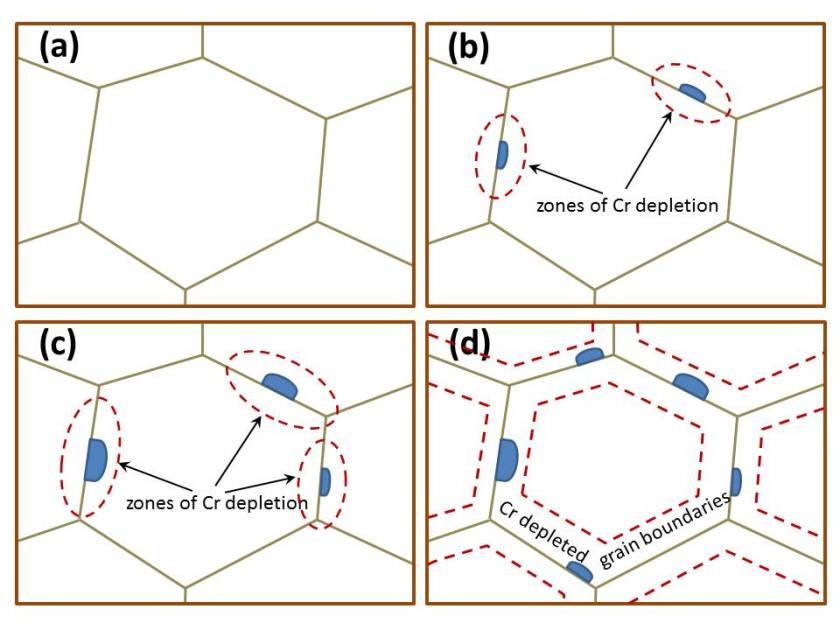There are some alloys among the tens of thousands that have been used commercially which are a resounding success. 316 Stainless Steel is one of those. It can be found in applications as diverse as commercial heat-exchangers, beer-making vessels, hip implants and even your kitchen sink. It has an enviable property balance that combines good ductility, high fracture toughness, moderate strength, excellent corrosion and oxidation resistance as well as reasonable fatigue resistance. When you combine these with the huge variety of ways in which it can be worked and joined along with its moderate cost, its suitability to a wide variety of applications becomes apparent.
The composition of this steel is shown in Table 3. The chromium is well beyond the level required to make this a stainless steel. This higher level makes the steel especially resistant to corrosion and oxidation. Despite this level of chromium, earlier similar steels were found to be susceptible to pitting corrosion. The addition of molybdenum largely eliminates this problem in all but the most aggressive of environments. Both the Cr and Mo stabilise the bcc crystal structure of iron. This is not ideal for formability and so a large amount of nickel is added—as a stabiliser of the fcc phase, this makes the steel austenitic. The Cr, Mo and Ni give rise to a significant level of substitutional solid solution strengthening.
The silicon, manganese, phosphorous and sulphur are all part of the routine chemistry of steel. The latter two being especially detrimental in terms of their potential for embrittling the steel and causing problems during welding. The silicon and manganese will provide some limited solid solution strengthening. Nitrogen, if present, will confer some strengthening in a similar way but is dissolved interstitially (between the metal atoms in the fcc lattice).
Table 3 The composition in wt% of 316 stainless steel.

The element carbon is the problematic addition in this steel and indeed in all the steels of the same family: austenitic stainless steels. The problem is known as sensitisation and manifests itself as a sensitivity to corrosion. So how can an alloy renowned for its resistance to corrosion become susceptible to corrosion? Figure 6 below shows how this happens. If an austenitic stainless steel is exposed to temperatures of around 500–750°C, during welding for example, Cr carbides can begin to precipitates at the grain boundaries as shown in Figure 6(a). Because these carbides contain a large amount of Cr—they have the chemical formula Cr23C6—they deplete the surrounding material of Cr. The progression of the precipitation and Cr depletion is shown in Figure 6(a)–(d). At the temperatures at which carbides form, Cr tends to diffuse faster at the grain boundaries than in the bulk. The consequence of this is shown in Figure 6(d), where Cr-depleted regions are present at all of the grain boundaries. If this depletion is severe then the boundaries will be susceptible to chemical attack. This is especially problematic because grain boundaries are already more susceptible to attack because they are regions of high energy.

Figure 6 A schematic of the Cr carbide precipitation and Cr depletion which leads to sensitisation.
There are fortunately various ways of addressing sensitisation. These include:
- Ensuring that the steel does not see exposure to elevated temperature.
- If the steel is exposed to the critical temperature range then it can be annealed afterwards at a much higher temperature—a few minutes at 1100°C, for example, will allow Cr to diffuse from the grain interiors to replenish the depleted zones.
- Reducing the carbon level—a reduction to a maximum of 0.03 wt% carbon gives a new steel called 316L, where L stands for low carbon.
- Adding titanium, niobium or tantalum in small amounts to the steel. These three elements are carbide formers which have such a strong desire for carbon that they ‘lock’ it up so it cannot form Cr carbides at the grain boundaries.
The issue of sensitisation has not held 316 stainless steel back from changing the world around us. If you have drunk milk or beer today it was pasteurised or made using 316 pipes and vessels. Some of the electricity powering your home today was almost certainly made possible using 316 heat-exchangers.
Sounds like a lot of research has gone into this theme! Good luck with the rest of the challenge
Debbie
LikeLike
It’s my day job so about 29 years research so far!
LikeLike